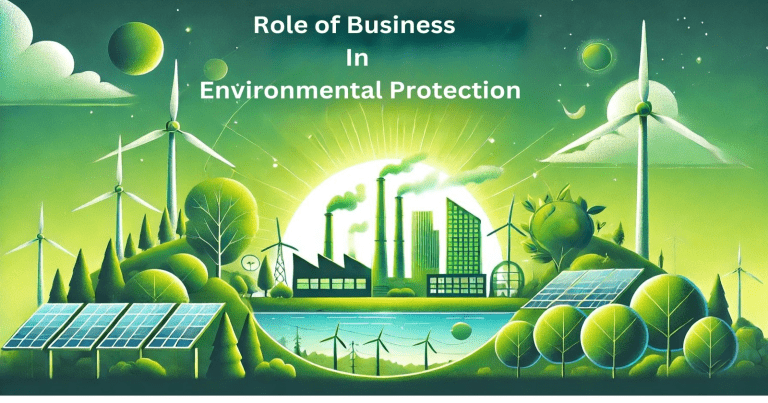Business plays a great role in environmental protection, and it has a direct impact on the health of our earth. Corporations can contribute as innovators in any major environmental problem. It can be caused by climate change, biodiversity loss, pollution, etc. Factors like economic factors, technological advancements, legal frameworks, market dynamics, and social pressure affect the business environment. The best possible shot for any business in an eco-friendly market is to be eco-friendly itself. An environment conducive to health is an environment that is also financially successful. Sustainable in relation to the environment on the other. The role of business in environmental protection is significant.
Conservation and Biodiversity Issues for Businesses
Conservation and biodiversity problems for business are biological differences in organisms including animals and their microorganisms. It also includes the overall ecosystems. Business involvement in environmental protection lies in tackling conservation and biodiversity problems.It can be done by damaging practices and contributing to sustainability actions.
- Deforestation and Habitat Destruction: Forest clearance for agricultural, urban, and industrial purposes contributes to deforestation. It loses its habitats and causes several species to face extinction. For instance, the growing plantations of palm oil resulted in the removal of the natural rainforests in Indonesia and Malaysia.
- Pollution: Industrial pollution entails the emission of harmful chemicals, heavy metals, and plastics into the environment. Example: Toxic oil spills by petroleum companies poison the ocean and kill the organisms. Industrial contamination of air by factories and power plants causes global warming and health breakdowns.
- Climate Change: The main source of climate change is companies and, as a consequence, greenhouse gas emissions. Climate change damages ecosystems, forcing species to migrate or become extinct.
How Business Can Tackle Conservation and Biodiversity Issues?
Businesses can obtain material from a sustainable source by applying certificates like FSC (Forest Stewardship Council) for wood or MSC (Marine Stewardship Council) for seafood.
- Reforestation and Afforestation Programs: Companies can mitigate their environmental footprint by planting trees and rehabilitating degraded environments. For instance, a furniture manufacturer can guarantee that its wood is from sustainably harvested forests thereby preventing forest degradation.
- Investment in Clean Technology: Companies can invest in solutions that minimize pollution and the reduction in resources. For example, plants can install emission-reduction air filters and install water recycling systems.
- Working with NGOs and Governments: Corporations may unite with environmental organizations to protect endangered species and ecosystems. Numerous corporations have sponsorships of WWF conservation projects targeted at biodiversity hotspots etc.
Steps by Which Businesses Can Keep the Environment Protected
Responsible and thoughtful business practices protect the environment. The above measures not only decrease the impact caused on the environment but also help improve the company’s reputation and loyalty among its customers. The following are some of the most effective measures that businesses can use to protect the environment.
Reduce Generation Of Waste
Decrease the Generation of Waste Businesses must adopt a circular economy model that decreases the generation of waste by companies.
Example:
- Recycling schemes can help business organizations convert waste material into new products.
- Food companies can donate extra food instead of dumping it.
- Electronic companies can start e-waste recycling so that the recovered metals can be used again.
Use Eco-Friendly Packaging
Businesses should switch from using single-use plastics to more environmentally friendly alternatives. Such alternatives can include:
- Biodegradable packaging is made from plant-based materials such as cornstarch.
- Reusable containers for takeout food delivery services.
- Package minimalist: minimal usage of material.
- For instance, cosmetics reduced its footprint on the environment by switching from one container to the other and having the paper packaging be recycled.
Perform Environmental Audits
Regular audits help companies identify areas for improvement in terms of reducing environmental impact.
For example:
- An energy audit can indicate any area that could be using much energy, prompting the organization to switch on energy-saving tools.
- A waste audit shows how much materials are being lost, thus improving the recycling plan of the business.
| Step | Environmental Benefit | Real-World Example |
| Reduce Waste | Decrease landfill usage | A restaurant chain donates leftover food |
| Use Renewable Energy | Cut greenhouse gas emissions | Tech firms installing solar panels |
| Eco-Friendly Packaging | Reduce plastic pollution | Online stores using compostable mailers |
Role of Business In Environmental Protection
An appropriate role of business in environmental protection will ensure a sustainable future. ECO-friendly operations, minimal or no waste output is to be encouraged. The promotion of conservation merges profitability with responsible environmental conduct. Sustainability is now not an option but a course to be adopted. It is a global environmental challenges that demand it and for consumer demand or government regulations.
Sustainable Environment Mechanism
Businesses embracing “greenness” remain ahead of regulatory requirements and avoid penalties and fines. Taking their stance on environmental protection, businesses help the planet without losing long-term growth and prosperity.
- Green Innovation Technologies: The creation of electric automobiles, solar energy panels, and energy-saving electronics by business organizations enables innovation in such technologies to control their adverse implications on the natural environment.
- Environmental-friendly Supply Chains: A company ensures material inputs come from responsible sources in their supply chain.
- Cost Savings: The less usage of energy or waste generated has a saving aspect on operational cost.
Investing in Green Technology
Investments in green technology not only help to reduce the environmental footprint but also provide savings to businesses in the long term. These green innovations of technology protect the environment.
- Ev (Electric vehicles): By decreasing emissions, from electricity-powered vehicles, logistics companies can employ the vehicles.
- Carbon Capture Systems: Carbon capture equipment can be fitted to product manufacturing plants that remove all emissions before they are released into the environment.
- Smart Building Solutions: Smart energy management facilities can learn how to use power intelligently and waste less.
Increasing Recycling and Circular Economy Practices
Recycling saves natural resources and reduces waste. Organizations can apply the circular economy principles. A company that produced mobile phones started a buyback (e.g., recycling) program in which customers returned used mobile phones on a regular basis to be recycled. Millions of pounds of e-waste were salvaged from landfills. Material Refurbishment or malfunctioning items can be remanufactured and reused in the manufacturing process.
- Household Recycling Operations: Companies can set up in-house recycling plants for paper, metals, and plastics.
- Reminding Consumers to Recycle: Retailers often offer discounts to customers who deposit used items (e.g., electronic waste or bottles).
Reduction of Plastic Use
If companies want to stem the global plastic pollution crisis, they can shift to environmentally safe options. Specific actions include:
- Switch to Biodegradable Packaging: Food delivery companies can use biomaterials, including bamboo, cornstarch compostable paper, etc.
- Replace Single-Use Plastics: Retailers can substitute plastic bags with paper or cloth bags.
- Refill System: Cosmetic companies can implement refillable containers that can cut packaging waste heavily.
- Effect: Less plastic will see a business in alignment with aims for the environment and also a reduction in marketing to eco-aware customers.
Conservation Advocacy
Companies can make a contribution to ecological and wildlife conservation by philanthropic project funding. Participating in the preservation efforts enables biodiversity conservation and develops a solid corporate social responsibility (CSR) image for the company. Eg, A beverage company investing in clean water projects in developing nations not only builds customer goodwill and delivers on its brand image but also delivers competitive gain.
- Planting to Offset Carbon Footprint: Planting trees in areas to create a carbon-neutral balance.
- Biodiversity Conservation: Companies can collaborate with NGOs in designing work and participate in the conservation of threatened species and their environment.
- Restoration of Wetlands: One component of the redevelopment parcels by real estate developers, is the restoration of degraded tidal wetlands.
Construction of Sustainable Supply Chains
As part of company-wide efforts toward sustainable development along the entire supply chain, a multinational coffee shop switched to fair-trade-certified coffee and biodegradable coffee cups.
- Source Green Materials: Organic, or certified, materials produce less harm to the environment.
- Sustainable Supply Chain Partners: Form partnerships with their suppliers committed, to green practices in order to maintain continuity in the supply chain.
- Reduce Transportation Emissions: Businesses can optimize delivery routes or use low-emission vehicles.
Environmental Audits
Periodic environmental audits help organizations identify opportunities for developing their business. Audits can deliver the company with actionable insights that can be used to make data-informed decisions on sustainability. For example, a packaging company reduced its waste by 30% by auditing its production process for inefficiencies. The steps include:
- Measuring Carbon Emissions: Companies monitor their greenhouse gas emissions to develop efficient mitigation measures. Audits may be applied by a company so as to understand the amount of water, energy, and raw materials that they consume.
- Evaluation of Waste Management: The company will identify the site where waste can be reduced or recycled.
Role of Business in Environmental Protection FAQs
Why is business so important to the environment?
Business has a damaging effect on the environment. Business participation in environmental conservation is one route towards sustainability and the conservation of biodiversity.
How do businesses manage the conservation aspect?
Industry conducts conservation within the framework of sustainable practice. They use eco-friendly materials, reforestation, and waste minimization.
What do business units undertake to protect biodiversity?
Companies can also help conserve biodiversity by reducing habitat destruction, avoiding overuse of resources, and promoting conservation activities.
Do sustainability practices pay?
Yes. Sustainability practices save resources, make businesses attractive to green-conscious customers, and allow businesses to seize investment opportunities in new, emerging green markets.
What is the connection of CSR with environmental protection?
Corporate Social Responsibility is a framework that encourages businesses to operate in an ethical and socially responsible way.


